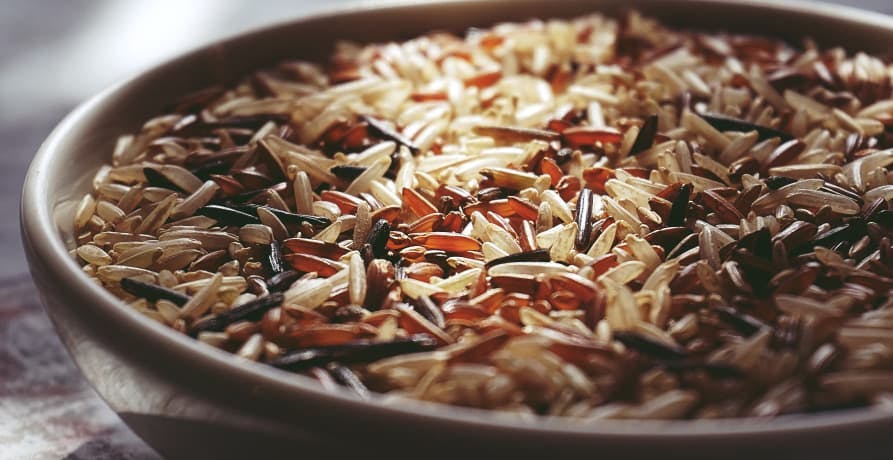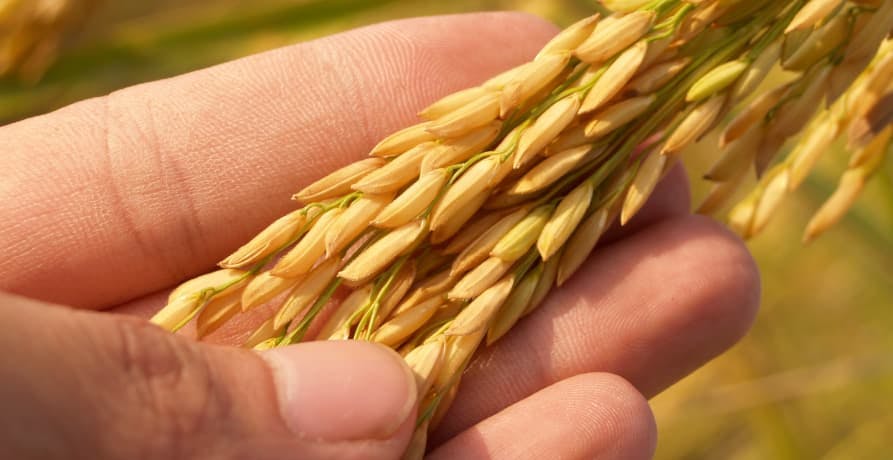ESG / CSR
Industries
Rice and the Climate Crisis : How do they Relate?



Rice is a food staple for over 4 billion people across the globe - half of the world's 8 billion strong population. The simple grain is a cornerstone of food security and helps to ensure that the world’s most vulnerable communities have access to an affordable source of nutrition.
However, the future of rice is now under threat from the increasing effects of climate change - something that could have profound effects on global food security and socio economic stability. This is why farmers, researchers and scientists alike are beginning to look for ways to make rice crops more resilient.
👉 In this article we’ll explore the significance of rice, why it’s being impacted by global warming, and what is being done to protect future rice supplies.
Why is rice important?
Rice may seem like a simple ingredient, but it’s a lot more important, complex and varied than you’d first think. It also plays a significant role in many different cultures.
There are over 120,000 different varieties of rice! And some of our best loved dishes use rice as a central ingredient - dishes like paella, sushi, bibimbap, nasi goreng, risotto, biryani… the list goes on. But the most commonly consumed variety of rice is known as Oryza sativa. It was cultivated in Asia and has since become the most popular rice variety across the world.
Rice forms such a central part of many cultures diet’s that it is now the primary source of energy for nearly half of the world’s population, particularly in Asia, Latin America and parts of Africa.
👉 Did you know? In Thailand the words for food - khaw or kab khaw - actually translate to ‘rice’, or ‘with rice’ - this is how important rice is to their diet!
But the significance of rice extends beyond its role as an ingredient - rice plays an important part in global food security and socio economic stability. Many poorer communities rely on rice as primary food source, and rice growers depend on crop output for their livelihood.
Rice is particularly susceptible to changes in output due to the fact that the rice market doesn’t have a lot of excess supply to meet demand. This means that where rice yields drop in one region, the rest of the supply chain is affected, resulting in price increases and supply shortages.
This is why the threat to rice from climate change is a global concern. Climate change has the potential to impact rice outputs, which will put strain on the global supply chain - impacting farmers and impoverished communities most of all.

Rice and climate change
Climate change is threatening the future of rice. And given the important role that rice plays in many people's diets and livelihoods (particularly in developing nations), this also presents a significant threat to these communities too.
The effects of climate change are being felt around the world. Extreme weather events like drought, flooding and storms are increasing in intensity and frequency, and changes to weather patterns are resulting in long term changes to the climate which is significantly impacting the agriculture sector.
Rice is particularly vulnerable to these changes. In periods of drought there may not be enough moisture to allow the seedlings to grow. At other times there’s too much water, which means that the plants drown. Rice is also often grown in areas with a low elevation which makes them vulnerable to rising sea levels. Even rising temperatures threaten the ability to grow rice - heat stress has been proven to impair the ability of the plant’s flowers to pollinate, which significantly reduces the yield of rice crops.
Rice has been called “the cultivated crop most vulnerable to future changing climates”.
The human impact of failing rice crops
The impacts of lower rice yield or even failed crops, run deep. Farming families suffer the economic impacts, struggling to make a decent living. Where crops consistently fail, families who rely on rice for their income may even be forced to move, or to find work elsewhere.
👉 Did you know? Nearly 560 million people living on less than US$1.25 per day are in rice-producing areas, far more than for any other crop. Rice is the most important food crop of the developing world.
Falling rice crop yields combined with growing populations in Asia also mean that countries may struggle to remain self-sufficient in terms of food production. This is hugely problematic because rice plays an important role in preventing malnutrition and starvation in impoverished areas. Rice is a relatively cheap staple food that provides important nutritional benefits. Where prices rise, or availability becomes an issue, poor communities will be the most impacted.

Rice - victim and contributor
While, on the one hand, rice is under growing threat from the effects of climate change, it should also be acknowledged that it’s a contributor to the problem. Traditional cultivation methods - for example, flooding paddy fields and burning rice straw - contribute around 10% of man-made methane emissions globally.
👉 Methane is harmful to the environment and is a contributing factor to global warming. Methane traps heat in the atmosphere, which results in rising global temperatures. And although it has a relatively short life span compared to some other greenhouse gasses, it is more efficient at trapping the heat.
The problem with industrial farming
The challenges faced by rice farmers were very different half a century ago. At this point in time the concern was simply producing enough rice to feed the world’s growing population and to prevent famine.
Farming adapted to this challenge, through the introduction of hybrid seeds that produce higher yields of rice crop and the use of chemical fertilizers. Ricer farmers were able to produce as many as three harvests a year, increasing rice output dramatically and helping to feed the global population at an affordable cost.
However, this came at a cost and this system of intensive farming created its own problems. It resulted in depleting aquifers (permeable rock that works to store or transmit groundwater), reduced the varieties of rice that is grown (monocropping increases the risk of disease or pests), and polluted the air through the burning or rice stubble.
One example that illustrates the complex interplay between rice farming and climate change can be found in Vietnam’s rice fields in the Mekong Delta. The flat plains or rice fields in Vietnam are under threat from rising sea levels. Only a few decades ago salt water would only travel 30km inland, whereas these days it’s closer to 70km.
In response to their changing environment, rice farmers in coastal regions are now alternating between rice and shrimp farming. However, this comes with a risk. Shrimp farming is damaging the land, causing it to become barren.
This example helps to illustrate why it’s so important that we not only address the issue of declining rice yields, but do so in a sustainable manner that doesn’t cause further harm to our environment.
What can we do to protect rice crops?
As our world continues to warm, and we continue to feel the effects of climate change, rice producers are being forced to reconsider how they’re farming one of the world's most important crops.
Changes to weather patterns mean that farmers are altering their farming calendar, more resilient varieties of rice are being planted, and scientists are even working on creating more heat resistant varieties. Let’s take a closer look at some of the work being done to protect global rice supplies:
New rice varieties
There are over 120,000 different varieties of rice and each variant brings its own unique advantages and disadvantages. By studying these different variants and their genetic qualities, researchers hope to be able to determine which varieties are the most resilient when it comes to climate change and rising temperatures.
This means that farmers will be able to start replacing current varieties with these more robust plants, which will help to limit some of the effects of global warming.
It will also allow biochemists to potentially develop new hybrid variants that are better adapted for a hotter climate.
CRISPR crops
CRISPR technology (a gene editing method) is an exciting new area of science that is allowing scientists to create completely new crop variants, specifically designed to meet specific challenges. For example, CRISPR technology is allowing scientists to make more nutritious vegetables and fruit, to create pest and disease resistant strains, and even develop rice seeds that produce virtually no methane.
This is incredibly exciting in the context of rice farming which produces large amounts of methane as a by-product. It’s also hoped that CRISPR technology may be able to help to create new rice plant varieties that allow them to grow in salty water, or to survive being submerged in floodwater for prolonged periods of time.
👉To read more about CRISPR technology and its potential benefits for global food supply and the fight against climate change, why not check out our article on the topic.
Reduced water in rice paddies
Rice farming is a traditionally water-intensive farming practice - something that’s becoming an increasing issue with more frequent periods of drought, erratic rainfall, and generally hotter climates.
The use of water is also the reason behind the high levels of methane that is produced by rice farming. The water works to block oxygen from penetrating the spoil, which creates the perfect environment for bacteria that produce methane. The longer the water rests there, the more methane producing bacteria that’s able to accumulate and grow.
These challenges have prompted farmers and researchers to develop new methods of rice farming. For example, there is a new method being trialed whereby the rice fields are drained of their water, then allowed to dry out a bit, before being flooded again - this process is then repeated throughout the harvest. Researchers studied the result of this practice over a 7 year period and determined that resulting methane emissions could be decreased by as much as 60%.
Another example of practices that reduce water use and cut methane emissions can be found in China, where farmers plant rice in rows, leaving furrows for the water to flow between.
The future of rice
Global rice production has never been more in demand, with growing populations and an escalating cost of living crisis, rice offers an affordable and nutritious staple for many households across the world.
However, our food systems are under threat from the growing impacts of climate change - something that is threatening the future of rice yields and increasing the vulnerability of the world’s poorest communities.
This is why it’s so important that we take steps now to make our food systems more resilient. This includes steps to decarbonise the agriculture sector generally, while also developing more climate resilient crop varieties.
What about Greenly?
At Greenly we can help you to assess your company’s carbon footprint, and then give you the tools you need to cut down on emissions. Why not request a free demo with one of our experts - no obligation or commitment required.
If reading this article has inspired you to consider your company’s own carbon footprint, Greenly can help. Learn more about Greenly’s carbon management platform here.





